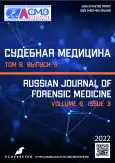Морфологические признаки смертельной острой общей холодовой травмы на воздухе
- Авторы: Чудаков А.Ю.1, Божченко А.П.2, Хрусталева Ю.А.2, Толмачев И.А.2
-
Учреждения:
- Санкт-Петербургский университет Министерства внутренних дел Российской Федерации
- Военно-медицинская академия имени С.М. Кирова
- Выпуск: Том 8, № 3 (2022)
- Страницы: 47-55
- Раздел: Оригинальные исследования
- URL: https://journals.rcsi.science/2411-8729/article/view/122466
- DOI: https://doi.org/10.17816/fm742
- ID: 122466
Цитировать
Полный текст
Аннотация
Обоснование. В Российской Федерации в силу особенностей её географического положения холодовая травма занимает одно из ведущих мест в структуре насильственной смерти. Несмотря на большое количество исследований, остаются недостаточно изученными патофизиологические процессы, происходящие в организме человека при гипотермии, в том числе отсутствуют точные количественные характеристики диагностических признаков, наиболее часто используемых в экспертной практике.
Цель исследования ― уточнить и дополнить комплекс характерных и патогномоничных макро- и микроскопических признаков смертельной острой общей холодовой травмы.
Материал и методы. По материалам судебно-медицинских экспертиз в отношении 460 трупов людей, умерших от переохлаждения на воздухе, проанализированы морфологические признаки смерти от общего переохлаждения. Использованы методы описательной статистики, содержательно- и формально-логические методы.
Результаты. Уточнены, дополнены и систематизированы макро- и микроскопические признаки холодовой травмы. Дана количественная оценка частоты встречаемости (выявляемости) диагностически значимых признаков, наиболее часто используемых в экспертной практике. Установлено, что главные признаки смерти от общего переохлаждения включают ишемию «оболочки» в сочетании с полнокровием и отёком «ядра» тела, сгущение крови со свёртками, микро- и макротромбоз с кровоизлияниями во внутренние органы (головной мозг, оболочки мозга, сердце, лёгкие, почки, желудок и т.д.), спазмирование (окоченение) различных групп мышц, трофические и некротические изменения во внутренних органах.
Заключение. Выявленные признаки смерти от общего острого глубокого переохлаждения на воздухе расширяют имеющиеся представления о комплексе характерных и патогномоничных признаков при данном виде травмы и позволяют надёжно проводить дифференциальную диагностику причины смерти при производстве судебно-медицинской экспертизы трупа.
Полный текст
Открыть статью на сайте журналаОб авторах
Александр Юрьевич Чудаков
Санкт-Петербургский университет Министерства внутренних дел Российской Федерации
Email: chief.chudakow@yandex.ru
ORCID iD: 0000-0003-3443-7908
SPIN-код: 2822-8027
д.м.н., профессор
Россия, Санкт-ПетербургАлександр Петрович Божченко
Военно-медицинская академия имени С.М. Кирова
Автор, ответственный за переписку.
Email: bozhchenko@mail.ru
ORCID iD: 0000-0001-7841-0913
SPIN-код: 1110-0515
д.м.н., доцент
Россия, Санкт-ПетербургЮлия Александровна Хрусталева
Военно-медицинская академия имени С.М. Кирова
Email: khrustaleva-julia@yandex.ru
ORCID iD: 0000-0001-5282-7219
SPIN-код: 3622-5270
д.м.н., доцент
Россия, Санкт-ПетербургИгорь Анатольевич Толмачев
Военно-медицинская академия имени С.М. Кирова
Email: 5154324@mail.ru
ORCID iD: 0000-0002-5893-520X
SPIN-код: 5794-9030
д.м.н., профессор
Россия, Санкт-ПетербургСписок литературы
- Пиголкин Ю.И., Солодовников В.И., Кислов М.А., Оганесян Н.С. Сравнительная эпидемиология термической травмы и гипотермии // Судебно-медицинская экспертиза. 2021. Т. 64, № 2. С. 4–9. doi: 10.17116/sudmed2021640214
- Shalaby S.A., Fouad Y., Azab S.M., et al. Predictors of mortality in cases of thermal burns admitted to burn unit, ain shams university hospitals // J Forensic Leg Med. 2019. N 67. Р. 19–23. doi: 10.1016/j.jflm.2019.07.011
- Божченко А.П., Исаков В.Д., Ягмуров О.Д., и др. Сравнительный анализ объема и структуры ненасильственной смерти в Санкт-Петербурге и Новгородской области за последние 5 лет // Судебно-медицинская экспертиза. 2022. Т. 65, № 3. С. 10–14. doi: 10.17116/sudmed20226503110
- Богомолова И.Н., Богомолов Д.В., Перепелкин А.В., и др. Микроскопическая дифференциально-диагностические признаки смертельной холодовой травмы. Методические рекомендации. Москва, 2014.
- Шигеев В.Б., Шигеев С.В., Колударова Е.М. Холодовая смерть. Москва: Новости, 2004. 184 р.
- Чудаков А.Ю. Судебно-медицинская и физиологическая характеристика острой общей глубокой акцидентальной гипотермии: Автореф. дис. ... канд. мед. наук. Санкт-Петербург, 1997. 23 с.
- Десятов В.П. Смерть от общего переохлаждения организма: Автореф. дис. … докт. мед. наук. Томск, 1969. 27 с.
- Райский М.И. К учению о распознавании смерти от холода: Автореф. дис. … докт. мед. наук. Томск, 1907. 27 с.
- Пупарев К.В. Втянутые testis вверх к брюшному кольцу, как признак постоянный и более других признаков характеризующий смерть от замерзания // Друг здоровья. 1847. № 43. С. 339–340.
- Blonssfeld T. Die gerichtsarztliche auffassung der todesursachen besondere uber den tod durch erfrieren in beziehungzu seinen bedingungen und ursachen // Z Staatsarzneikunde. 1860. N 40. Р. 143–174.
- Dieberg C. Hundert gerichtliche Sektionen. Tod durch Kalte // Vierteljahresschr gerichtl Offetl Med. 1864. N l. Р. 303–316.
- Пухнаревич В.И. Некоторые наблюдения при исследовании трупов лиц, умерших от охлаждения // Судебно-медицинская экспертиза. 1960. № 3. С. 48–50.
- Вишневский С.М. Новый признак смерти от замерзания // Вестник общей гигиены, судебной и практической медицины. 1895. № 1. С. 11–20.
- Никольский И.И. По поводу судебно-медицинского значения геморрагии слизистой оболочки желудка при смерти от замерзания // Вестник общей гигиены, судебной и практической медицины. 1898. № 2. С. 1009–1013.
- Фабрикантов П.А. К морфологическим признакам смерти от охлаждения тела. Сборник научных работ по судебной медицине и пограничной области. Москва: Медгиз, 1955. 70 с.
- Осьминкин В.А. Патоморфология легких при смерти от переохлаждения на воздухе: Автореф. дис. … канд. мед. наук. Ленинград, 1988. 22 с.
- Смыслова А.М. К вопросу о распознавании смерти от замерзания: микроскопические изменения в легких при действии низкой температуры. Санкт-Петербург, 1909. 84 с.
- Касьянов М.И. Очерки судебно-медицинской гистологии. Москва: Медицина, 1954. 142 с.
Дополнительные файлы







